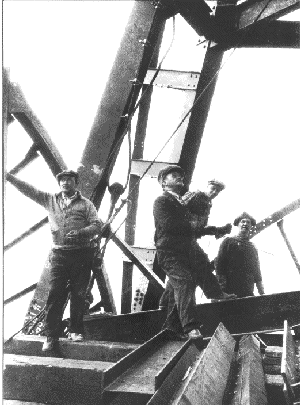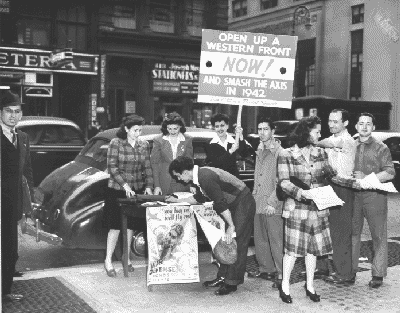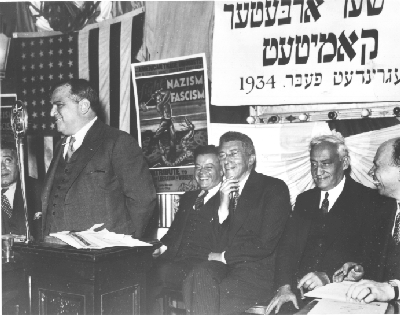
The Record - March 1998
Rescuing Records in the "Cradle of American Labor":
The Robert F. Wagner Labor Archives
By Janet Wells Greene
The National Historical Publications and Records
Commission, a federal grant agency and part of the National Archives and Records
Administration, provides financial support to help preserve and publish records
documenting American history. Commission funds have helped the Robert F. Wagner
Archives make available for research materials relating to the history of labor
in New York.
At a time when many Archives consider their collections complete, the Robert
F. Wagner Labor Archives at New York University continues to scour the city
for documents related to the history of labor and working people in New York.

Iron workers construct the Chrysler Building, New York City, 1929.
(Charles Rivers Collection, Robert F. Wagner Archives)
"It is urgent that this work be done," explains Debra Berhardt, historian and director of the Robert F. Wagner Labor Archives at New York University. "Many labor organizations no longer exist, and the records that document organized responses to changes in work and the workplace during the past 100 years will be lost if we don't act quickly to save them."
In 1880, Samuel Gompers, founder of the American Federation of Labor, called New York City the "cradle of the American labor movement." That movement outgrew its cradle after 1900; by mid-century New York became home to more than 600 local organizations as well as the headquarters of more than 20 national unions. But there were no labor Archives in the city until 1977, although the New York Public library had gathered a number of records. Several unions, including the Furriers, Needle Trades and the International Ladies' Garment Workers' Union sent their records outside the city to Cornell University's Labor-Management Documentation Center at Ithaca.
The Wagner Labor Archives, named for the late Senator, was created as a repository for the historically significant, non current records of New York City labor organizations in 1977. Co-sponsored by the Tamiment Institute and the New York City Central Labor Council, the combined Tamiment-Wagner collections today total more than 7,500 linear feet of records, including tape recordings of 3,600 oral histories, and 225,000 photographs and other non-print materials.
The earliest records gathered by the Archives illustrate the diversity of the work force in New York: musicians (American Federation of Musicians, Local 802), social workers (Social Services United Employees, Local 371), and the men who built the caissons which anchor the Brooklyn Bridge (Tunnel Workers Local 147). Subsequent acquisitions document the histories of workers and unions in the traditional crafts unions, such as the building trades, electrical work, and paperhangers; engineering; entertainment; office and communications; public employees (including transport workers), and wholesale, retail and manufacturing.
As the Archives staff began to collect records, they also worked to document what records had survived the city's fires, floods and building demolitions. In 1984, with funding from the National Historic Publications and Records Commission, a hardy crew of archivists and historians donned gloves, masks, and sometimes hip boots for a two-year search of the basements and storerooms of 400 labor organizations in New York City. The resulting Harry Van Arsdale Labor Documentation Survey has served as a guide to collecting efforts in the ensuing years.
During 1997 alone, more than 1,000 feet of documents were brought into the Archives. The extraordinary growth of the Wagner Labor Archives has been made possible by generous financial support from labor, government agencies, foundations, and individuals. These grants augment the operating funds provided by New York University. In 1998, the Archives has mounted a special campaign to raise $1 million to celebrate its 20th anniversary and preserve disseminate the history of labor in the United States well into the next century.

Members of District 65 of the United Auto Workers sell war bonds during World
War II.
The records of this organization of workers in the wholesale, dry goods, and
garment supply business in NewYork City span the years 1933 and the union's
bankruptcy in 1986. The collection includes 30,000 negatives from the union's
Camera Club. (District 65, UAW, Robert F. Wagner Labor Archives) 
New York Mayor Fiorello La Guardia addresses a meeting of the Jewish Labor
Committee in 1935. Seated behind him are two founding members of the JLC, David
Dubinsky of the International Ladies' Garment Workers Union and B. Charney Vladeck,
chairman of the JLC. The JLC collection is among the largest in the Wagner Archives.
Major efforts of this organization include an anti-Nazi boycott and efforts
to reform U.S. immigration laws that excluded refugees. The JLC secured visas
for more than 2,000 people to enter the United States. (JLC Collection, Robert
F. Wagner Labor Archives)